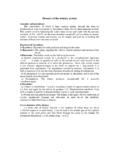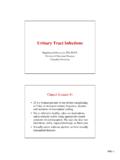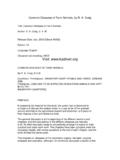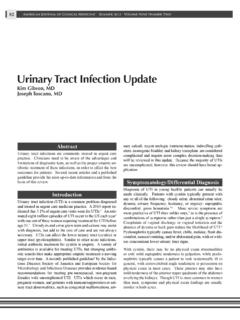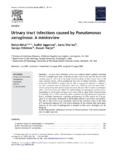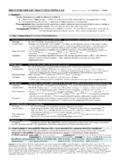Transcription of THE URINARY SEDIMENT - انجمن علمی دکترای ...
1 THE URINARY THE URINARY SEDIMENT l I love you urineyou, urineTHE URINARY SEDIMENTTHE URINARY SEDIMENT Introduction Main methodological aspectsThe particles of the URINARY The particles of the urinarysediment of nephrological importance The URINARY SEDIMENT in clinical practiceCli ConclusionsINTRODUCTIONINTRODUCTIONAN HISTORICAL PERSPECTIVE Introduced into clinical practice in Paris by Fi R d E N Vil i 1837 Fran ois Rayer and Eug ne N. Vigla in 1837 By the end of the 19th century all the i l idifi d d h i i yyparticles identified and the main urine profiles described A progressive decline in the 20th century, with the only exception, in the 1920s.
2 For the contributions of Thomas Addis the contributions of Thomas Addis Some new interest after the paper in KI by Fairley and Birch on the utility of URINARY Fairley and Birch on the utility of URINARY red cell morphology evaluation by pha-coTHE URINARY SEDIMENT TODAYTODAY Mostly performed in central laboratoriesfar from bedside and without the correct klequipment and knowledge With the dream to entrust the whole test to With the dream to entrust the whole test to automated instruments, which are already on the market (UF100and iQ200) Too often neglected even by nephrologistsN MAIN METHODOLOGICAL METHODOLOGICAL ASPECTSASPECTSMAIN METHODOLOGICAL ASPECTSA t i ll ti A correct urine collectionA d di d h d A standardized methodfor the handling of urine A proper microscope A proper reportA CORRECT URINE COLLECTION Give the patient written and simple instructions:pp- Collect the first or the second urine of the morning- Avoid strenuous physical effort- Wash external genitaliaMl th l-Male: uncover the glans- Female.
3 Spread the labia of vaginaCollect midstream urine-Collect mid-stream urine Avoid urine collection during menstruation Give the patient a proper urinecontainer Give the patient a proper urinecontainerA STANDARDIZED METHOD FOR THE HANDLING OF URINE 3 Second urine of the morning produced over a period of two hours3 Centrifugation of a 10 ml aliquot of urine for 10 min at of ml of supernatant urine3 Gentle but thorough resuspension by pipette of the SEDIMENT in the remaining ml of urine3 Transfer by pipette of 50 l of resuspended urine to a glass slide covered with 32 x 24 mm coverslipp3 Examination of the samples at low (160x) and high (400x) magnification within 3h from collection3 Particles expressed as lowest-highest number/microscopic fieldNB Avoid pouring off procedures and delaysin handling the samplesNB.
4 Avoid pouring off procedures and delaysin handling the samplesA PROPER MICROSCOPE A PROPER MICROSCOPE *Of good quality*Low magnification (eg, 160x)*High magnification (eg 400x)*High magnification (eg, 400x)*Phase contrast*Polarized lightPHASE CONTRASTBRIGHT FIELDURIC ACID - PHASE CONTRASTURIC ACID - POLARIZED LIGHTLIPID DROPLETS - PHASE CONTRASTLIPID DROPLETS - POLARIZED LIGHTA URINARY SEDIMENT REPORT A URINARY SEDIMENT REPORT DATE .. SURNAME NAME SURNAME .. NAME .. pH .. DENSITY ..HAEMOGLOBIN.
5 LEUKOCYTE ESTERASE .. ERYTHROCYTES: .. ISOMORPHIC (%)..DYSMORPHIC (%) .. ACANTHOCYTES (%).. LEUKOCYTES: .. TUBULAR CELLS: .. TRANSITIONAL CELLS: SUPERFICIAL .. SQUAMOUS CELLS: .. CASTS TYPES CASTS: ..TYPES: .. LIPIDS: .. CRYSTALS: .. BACTERIA: YEASTS: BACTERIA: .. YEASTS: .. OTHERS: .. URINARY SEDIMENT REPORT A URINARY SEDIMENT REPORT DATE .. SURNAME .. NAME .. pH.
6 DENSITY .. : ..+++..LEUKOCYTE ESTERASE ..+++.. ERYTRHOCYTES: ..1 3 ISOMORPHIC (%) ..DYSMORPHIC (%) .. ACANTHOCYTES (%).. LEUKOCYTES: ..1-2 TUBULAR CELLS: ..//.. TRANSITIONAL CELLS: SUPERFICIAL: .. //..DEEP: .. SQUAMOUS CELLS: .. //.. CASTS: ..//..TYPES: .. LPD // LIPIDS: ..//.. CRYSTALS: ..//.. BACTERIA: ..//.. YEASTS: ..//.. OTHERS: ..//.. COMMENT. MILD ERYTHROCYTURIA AND NOTE THE DISCREPANCY BETWEEN DIPSTICKS FOR HAEMOGLOBIN AND LEUKOCYTE ESTERASE AND MICROSCOPY. THIS IS PROBABLY DUE TO CELL LYSIS CAUSED BY LOW DENSITY. PARTICLES OF THE URINARY SEDIMENT OF URINARY SEDIMENT OF NEPHROLOGICAL IMPORTANCEPARTICLES OF NEPHROLOGICAL IMPORTANCEIMPORTANCE CellsLi id Lipids CastsCasts Crystals MicroorganismsCELLSTYPESUBTYPETYPEERYTHR OCYTESSUBTYPEI somorphicDysmorphicLEUKOCYTESN eutrophilEosinophilLymphocyteFROM BLOODMACROPHAGESyp yGranularHomogeneousPhagocyticTUBULAR CELLSP hagocyticProximal DistalTRANSITIONAL CELLSSQUAMOUS CELLSS uperficial DeepSuperficial EPITHELIALSQUAMOUS CELLSS uperficial DeepDeepERYTHROCYTESERYTHROCYTES A frequent finding (53% of samples)(53% of samples) Two main types.
7 Glomerular and non glomerular and non glomerularGLOMERULAR OR DYSMORPHIC ERYTHROCYTESNON GLOMERULAR OR ISOMORPHIC ERYTHROCYTESF airley K and Birch DFFairley K and Birch DFHi Hematuria: A simpl m th d f A simple method for identifying glomerular identifying glomerular bleeding Kidney Int 1982; 21: 105-08 FASSETT RG, HORGAN BA,MATHEW THMATHEW THEE DETECTION OF GLOMERULAR BLEEDING BY PHASE-CONTRAST MICROSCOPY> 80% cut-off for the definition of a haematuria as glomerular or non glomerularLancet 1982; I: 1432-34 PROBLEMS ASSOCIATED WITH THE ANALYSIS OF URBC MORPHOLOGYANALYSIS OF U-RBC MORPHOLOGY Ri i Requires experience Is s d t th isk f l Is exposed to the risk of lowinter-observer reproducibility Still lacks of univocal criteria for dfii ht i lldefining a haematuria as glomerularor non glomerular K hler H, Wandel E, Brunck BAcanthocyturia-A canthocytur a characteristic marker for ll ldglomerular bleedingKidney Int 1991.
8 40:115-20 ACANTHOCYTE OR G1 CELL (SEM)ACANTHOCYTES OR G1 CELLS (PH-CO) E E E EDIAGRAM OF THE COMMONEST TYPES OF ACANTHOCYTESOR G1 CELLSLEUKOCYTEST ypesMore often PMNs (but also eosinophils and lymphocytes)SourceFor PMNs, any segment of ,ygthe URINARY tract(without forgetting genital contamination)Clinical meaningcontamination)Inflammation of whatevergcause including immunologicaldisorders (eg, glomerulardiseases)POLYMORPHONUCLEAR LEUKOCYTESEOSINOPHILS (BY MGG)DISEASES ASSOCIATED WITH EOSINOPHILURIAN HANSELWRIGHTURINE STAINAIN11102 RPGN1044 Postinfectious GN611 ATN3000 Acute pyelonephritis 1000 Acute prostatitis1062 Nolan III RC et al: NEJM 1986.
9 315:1516-19 LYMPHOCYTES (by PH-CO)LYMPHOCYTURIALYM H Y UA l k f t lll An early marker of acute cellular rejection of renal allograftjf gf Sensitivity 80 90% Sensitivity 80 -90%Si d hlil hi Stains and cythological techniques neededneededTUBULAR CELLSD ifferent morphological Different morphological subtypes fromdff l different tubular segmentsPROXIMAL TUBULAR CELLDISTAL TUBULAR CELLCOLLECTING DUCT CELLTUBULAR CELLSA cute tubularAcute tubularnecrosisClinicalAcute interstitialmeaningnephritisgpGlomerular d diseases (especiallyproliferative types) URINARY LIPIDSA ppearanceFatty dropletsppyp Oval fat bodies Fatty castsCholesterol crystalsSourceLipid ultrafiltration dueto abnormal GBM blpermeabilityLIPID DROPLETSINTRACELLULAR LIPIDS OVAL FAT BODY FATTY CASTCHOLESTEROL CRYSTALURINARY LIPIDSC linical meaning Marked proteinuriaMarked proteinuria Lipid storage diseases Lipid storage diseases(eg, Fabry disease)Birch DF et al.
10 A color Atlas of Urine Microscopy, 1994 CASTSF ormationDistal tubules d lland collectingductsMatrixTammHorsfallMatrixT amm-HorsfallglycoproteinDifferentDiffere nt clinicalfffftypesmeaningsERYTHROCYTE CASTLEUKOCYTE CASTBACTERIAL CASTYEAST CASTURINARY CRYSTALS COMMON CRYSTALS COMMON CRYSTALS PATHOLOGICAL CRYSTALSCRYSTALS DUE TO DRUGS CRYSTALS DUE TO DRUGSURIC ACID (U-pH )CALCIUM OXALATEMONOHYDRATED (U-pH < ) CALCIUM OXALATE BYHYDRATED (U-pH < )CALCIUM PHOSPHATE (U-pH )TRIPLE PHOSPHATE (U-pH )PATHOLOGICAL CRYSTALSPATHOLOGICAL CRYSTALS CHOLESTEROL CYSTINE LEUCINE TYROSINELEUCINE TYROSINE28 DIHYDROXYADENINE 2,8 -DI-HYDROXYADENINECHOLESTEROLCYSTINE2,8- HYDROXYADENINE (BF)2,8-HYDROXYADENINE (POL)Adenin phosphoribosyltransferase(APRT) d fi i(APRT) deficiencyAPRTA denosine AdenineAdenosine monophosphateXANTINEOXIDASE2,8 -dihydroxyadenine (2,8-DHA)(highly insoluble at any pH)APRT DEFICIENCYI nherited in an autosomal recessive mannerType I APRT deficiency:enzyme activity in erythrocyte lisate: virtually absenterythrocyte lisate.
